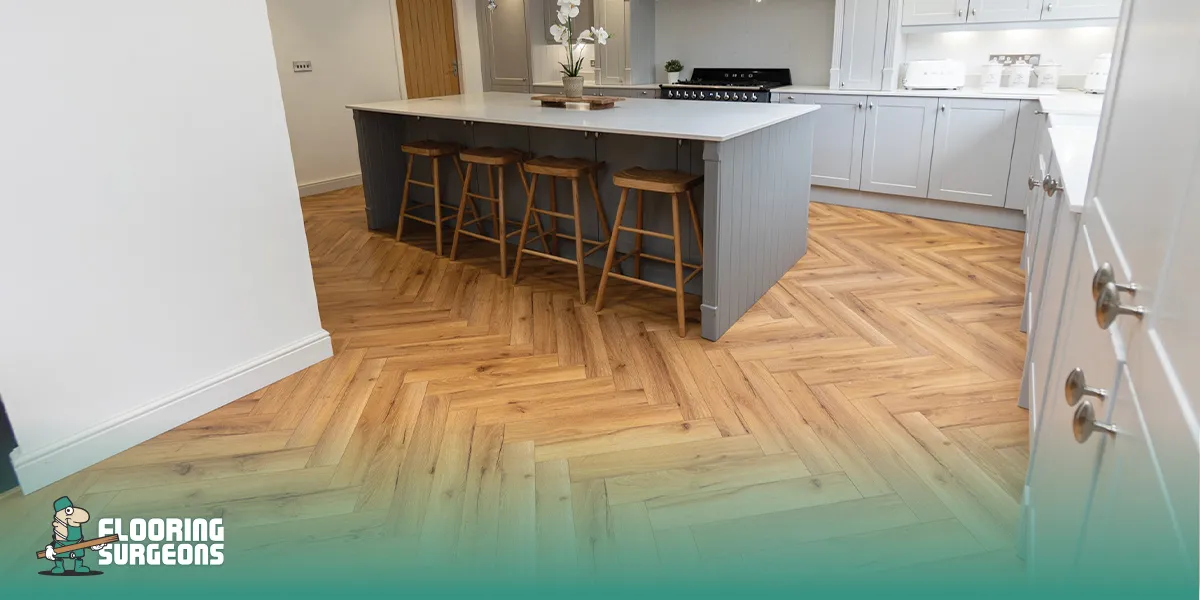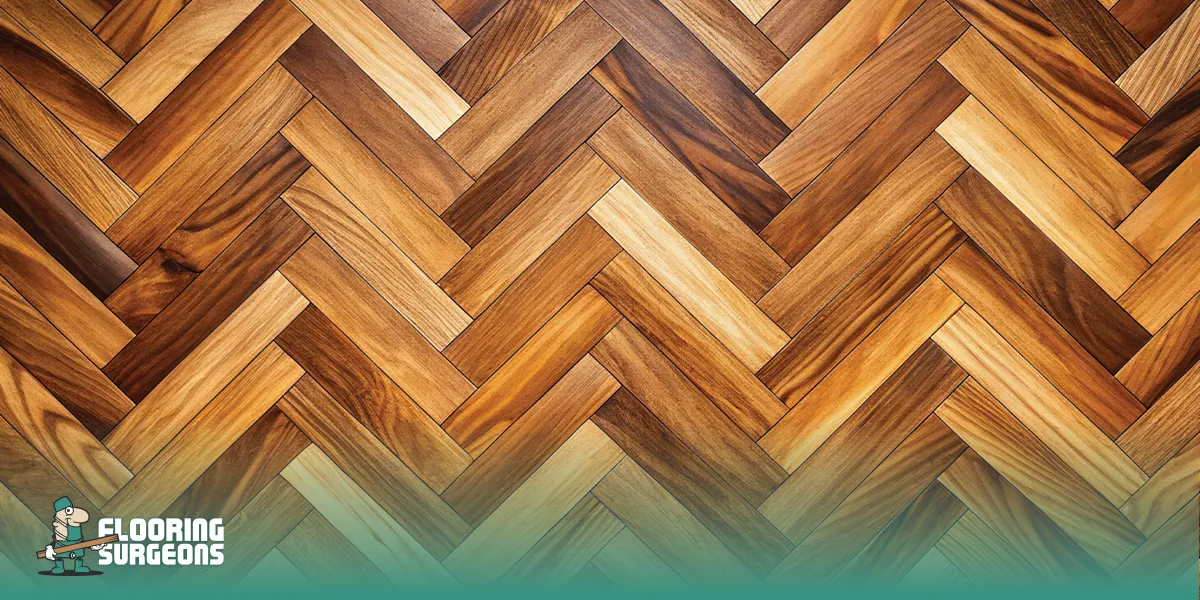A 20mm herringbone flooring isn't chosen for convenience; it's selected for presence. At this thickness, wood stops being a surface and becomes part of the architecture: heavier, quieter, warmer, and built to last for generations. If you're looking for flooring that not only elevates your interior today but preserves its beauty for decades, this is the standard that defines long-term value.
Not necessarily, it depends on the space. While 20mm is heavier and denser, it actually performs beautifully in most modern homes. The only time thickness becomes a concern is when door clearance or floor height transitions are limited. In return, the extra mass gives you a quieter, warmer, and more grounded feel underfoot — something thinner floors can’t replicate.
A properly installed 20mm plank can be sanded five to six times over its lifetime, roughly every 7–10 years. That’s the equivalent of replacing thinner floors multiple times. Each refinishing cycle removes minor wear and restores the original lustre, extending the lifespan beyond 40 years with ease.
The difference isn’t just in thickness; it’s in experience. A 12mm board offers stability and comfort; a 20mm board adds structure, silence, and permanence. You can feel it immediately: no hollow sound, no bounce, and a richer, more architectural look. The 20mm profile also allows deeper texturing and more refinishing cycles.
Yes, engineered 20mm herringbone is compatible with underfloor heating, as long as it’s built on a multi-layer core that resists movement. However, solid 20mm wood is not recommended, since it expands more with heat. Always follow the manufacturer’s temperature limits (typically below 27°C) to preserve the floor’s stability and finish.
This thickness pairs beautifully with heritage, luxury, modern, and minimalist interiors. In classic homes, it reinforces architectural depth. In modern spaces, it adds texture and grounding without overwhelming the design. The key is balance; darker tones for drama, lighter oaks for space and light.
Absolutely. A 20mm floor has greater acoustic mass, which means it naturally absorbs sound rather than reflecting it. It also retains heat longer, creating a more thermally comfortable environment, especially useful in open-plan homes or on upper floors where temperature fluctuations are typical.
European Oak remains the top choice for its strength and timeless grain pattern. American Walnut adds warmth and sophistication, ideal for luxury homes. Smoked Oak or Ash brings bold character and depth. Each species interacts differently with finishes: oak for versatility, walnut for richness, and ash for contrast.
Keep it simple and consistent.
Add felt pads under furniture to protect bevels.
For oiled finishes, re-oil every few years; for lacquered floors, occasional polishing restores sheen. A 20mm board’s depth means maintenance actually enhances its beauty over time.
Yes, if you view your home as a long-term investment. While initial costs are higher, the annual lifetime cost is lower than that of thinner floors that need replacement every decade. Plus, it increases property value; buyers recognise thickness and pattern precision as hallmarks of craftsmanship and durability.
Light plays a huge role. Because of its depth, 20mm flooring interacts with light differently — shadows appear deeper, grains more dimensional.
You don’t buy 20mm flooring because you want a floor. You buy it because you never want to buy another one. This thickness was developed for spaces where floors must last 30 to 50 years, withstand renovation cycles, and even increase property value through authentic materials.
Common concern: “Wouldn’t 20mm be too thick for modern interiors?” Answer: Only if your space is limited in height. Otherwise, the extra mass enhances sound, heat, and texture; all invisible luxuries that make daily life more pleasant.

When people imagine their dream floor, they rarely think in millimetres. They think about feeling stability, hearing silence, and seeing beauty age gracefully; qualities that define premium herringbone flooring, where craftsmanship meets timeless design.
The 20mm herringbone floor is built precisely for that:
A 20mm herringbone floor doesn’t just support your furniture — it supports the atmosphere of your home.
At this scale, flooring behaves more like architecture than décor. Each 20mm board features a high-density core and precision-milled joints that lock tighter than standard profiles.
Design Insight: Installers love 20mm herringbone because its heavier body and rigid structure make each angle (45° or 90°) sit flush without visible micro-shifts over time. Explore the 20mm Herringbone Flooring Collection at Flooring Surgeons, featuring oak, walnut, and hybrid finishes. Request free samples, or speak with our specialist advisors to design a floor that’s not only timeless, but built to stay.
20mm herringbone flooring is built for grand living rooms, heritage homes, high-traffic family spaces, and luxury commercial interiors; places that demand long-term strength, acoustic depth, and architectural presence. While it offers unmatched stability and a premium feel, it’s not ideal for low-threshold areas or weight-restricted floors, where a slimmer engineered option performs better.
Not for Every Setting: If your space has low thresholds, heated subfloors with limited output, or weight-restricted mezzanines, the 20mm option might be overbuilt. In those cases, 12mm engineered wood offers a similar style with lighter performance needs.

Herringbone flooring, by nature, demands absolute stability. Each chevron joint must meet precisely; even half a millimetre of shift can break the flow of the pattern. That’s where 20mm excels: it anchors the geometry so each piece stays true.
Visually, the added thickness creates a play of light and shadow that feels alive — deeper grooves, richer reflections, and more “sculpture” underfoot. It’s not just flooring; it’s an architectural feature that commands attention.
Pro Design Tip: Use wider planks (90–100mm) in 20mm thickness for a slower, grander rhythm across large rooms; perfect for stately or high-ceilinged interiors.
| Material Type | Why It Pairs Perfectly with 20mm Thickness | Design Effect |
| Solid Oak | Naturally dense, excellent for refinishing and historical authenticity. | Traditional, warm, long-lived. |
| Engineered Oak (Multi-layer Core) | Same thickness with improved dimensional stability — compatible with underfloor heating. | Modern, balanced, technical luxury. |
| Walnut or Smoked Oak | Darker, oil-rich wood complements weight and shadow play. | Rich, masculine, timelessly elegant. |
| Hybrid SPC 20mm Composite | The waterproof version, with similar density, is designed for commercial or moisture-prone areas. | Industrial, minimalist, ultra-durable. |
The extra depth allows for heavier texturing; brushed grains, deep bevels, and tactile finishes that make every step feel like craftsmanship.
A 20mm herringbone floor is an investment in time. While initial costs are higher, its lifespan exceeds 40 years, and refinishing resets its appearance multiple times. That means the actual cost per year is lower than that of thinner floors replaced every 10–15 years.
In property terms, thicker flooring signals quality; it adds both monetary and perceived value to homes, especially during resale. Architects often specify it for heritage projects, luxury homes, and design showpieces because it elevates the entire spatial experience. Homeowner’s question: “Will I ever need to replace it?” Answer: Only if you want to change the colour, not because it wears out.
| Feature | 10mm Herringbone | 12mm Herringbone | 20mm Herringbone |
| Feel Underfoot | Light & flexible | Solid & balanced | Dense, architectural |
| Durability | 15–20 years | 25–30 years | 40–50+ years |
| Refinishing Potential | 1–2 times | 3–4 times | 5–6 times |
| Sound Absorption | Medium | Excellent | Exceptional |
| Heat Retention | Average | Good | Best |
| Pattern Stability | Moderate | Strong | Absolute |
| Ideal For | Apartments, quick installs | Family homes | Heritage, luxury, and commercial spaces |
20mm herringbone flooring is the last floor you’ll ever need to install. It’s not for convenience; it’s for confidence. For those who see their home as a generational investment, not a temporary project, this floor offers permanence, precision, and personality.
Choosing a colour or finish for your 20mm herringbone floor isn’t about trends; it’s about how your home feels. At this level of craftsmanship, the tone, texture, and surface treatment shape a room’s mood more than furniture or paint ever could. Because of the floor’s extra depth, light behaves differently on 20mm planks; shadows are richer, reflections softer, and grain movement more visible. Below, we break down how different colours and finishes change not just the look, but the experience of your floor.
Light oak and bleached wood finishes turn thick herringbone flooring into an architectural diffuser of light. The pale surfaces scatter natural sunlight, brightening corners and expanding visual boundaries. This is especially effective in smaller or north-facing rooms that need to “borrow” light.
Unique Insight: The thickness of 20mm boards enhances the tactile depth of pale finishes — the grains aren’t just seen; they can be felt underfoot.
Mid-tone finishes such as honey oak, golden ash, or fumed oak are the most balanced colour range for 20mm herringbone floors. They have enough depth to feel luxurious but still reflect ambient light gracefully.
Example: In an open-plan living room, mid-tone 20mm oak creates the same cosy glow as afternoon sunlight, making large spaces feel naturally connected.
Dark tones on a thick herringbone plank do something magical: they absorb light rather than reflect it, creating a sense of visual intimacy. It’s the reason luxury hotels, piano rooms, and high-end offices so often choose dark flooring — it slows the eye down and grounds the room emotionally.
Design Tip: Go for a semi-gloss lacquer or hardwax oil finish to balance the darkness with a subtle, ambient reflection. Combine with warm LED lighting to emphasise the chevron angles.
Pro Insight: A 20mm dark floor absorbs both sound and light — turning echo-prone rooms into quiet, cocooned spaces.
Grey, taupe, and greige finishes have become staples of modern design, but their effect on a 20mm herringbone floor is more complex. Instead of feeling cold, the thickness gives them dimensional warmth; the undertones of beige, silver, or smoke catch the bevelled edges and create subtle gradients across the pattern.
Design Tip: Mix grey floors with off-white walls or natural linen fabrics to keep the palette warm rather than sterile.
Example: A brushed grey 20mm herringbone in a high-rise apartment absorbs city light beautifully, adding quiet sophistication.

Thickness allows creativity. A 20mm board can be sanded, brushed, smoked, oiled, or even hand-scraped multiple times without losing integrity. That means you can achieve finishes that aren’t possible with thinner flooring.
| Finish Type | Texture & Effect | Ideal Use |
| Brushed Matte Oil | Accentuates grain relief; hides minor scratches naturally. | Family homes, living areas. |
| Hardwax Oil | Deep lustre and natural warmth; highly breathable. | Classic or rustic interiors. |
| UV Lacquer (Matt/Satin) | Sealed, durable, stain-resistant. | Kitchens or busy spaces. |
| Smoked & Fumed | Enriched tone variation gives an aged, handcrafted character. | Heritage or boutique interiors. |
| Hand-Scraped Finish | Irregular texture that mimics antique parquet. | High-end restorations, statement floors. |
Pro Tip: 20mm boards hold surface treatments longer because the finish can bond more deeply into the grain, providing greater dimensional texture and longer-lasting protection.
When selecting your floor, don’t start by asking “what colour do I like?”
Ask:
Because 20mm herringbone flooring interacts with light like sculpture, your finish determines how the room feels throughout the day. Morning light on matte oak feels fresh; evening light on dark walnut feels like a low hum of elegance. In other words, you’re not just choosing a colour; you’re selecting the mood of your home. The beauty of a 20mm herringbone floor is that its colour isn’t painted, it’s carved, it’shed, and built into the wood itself. Lighter tones expand space; darker ones deepen it; textured finishes make it come alive under every beam of light.
Explore the 20mm parquet flooring Collection at Flooring Surgeons; available in natural oak, smoked walnut, brushed greige, and hand-finished textures. Request free samples to see how light, thickness, and colour come together in your own space.